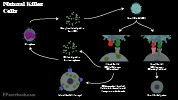Natural Killer Cell, NK cell, Large Granular Lymphocyte
- See Also
- Physiology
- Background
- Lymphocytes providing protection against Intracellular Bacteria and viruses, as well as cancer cells
- Respond to intracellular Viral Infections within first 3 days
- Similar destruction of virally infected cells as with Cytotoxic T Cells
- Part of Innate Immunity in which response is not based on prior exposure to pathogen
- Contrast with antibodies, B-Cells and T-Cells which have a learned pathogen response (Adaptive Immunity)
- Lack the Specificity of Adaptive Immunity
- Do not require MHC markers on Target Cells (unlike other Lymphocytes)
- In contrast, NK cells appear to Target Cells without MHC Proteins
- Natural Killer Cell Markers
- CD56 positive
- CD3 negative
- Lack other markers found on B Cells and T Cells
- Lymphocytes providing protection against Intracellular Bacteria and viruses, as well as cancer cells
- Activation of Natural Killer Cells
- Macrophage and Dendritic Cell derived Cytokines (e.g. Interleukin 12, type 1 Interferons)
- Deactivation of Natural Killer Cells
- Natural Killer Cells bind Major Histocompatibility Complex 1 (MHC-1)
- MHC-1 is present on normal cells and it inactivates NK cells
- MHC-1 is NOT expressed by infected cells
- NK activating receptor Ligand is expressed
- NK cells bind infected cells and destroy them
- NK cell mechanisms of infected cell destruction
- Cytoplasmic granules released, resulting in Target Cell lysis
- Perforin
- Generates pores on cells targeted for destruction
- Granzyme
- Induces programmed cell death (apoptosis) on entry into Target Cells
- Perforin
- Cytokines
- Tumor Necrosis Factor A (TNFa)
- Granulocyte Macrophage Colony Stimulating Factor (GM-CSF)
- Chemokines (CCL1-5 and CCL-8)
- Interferon-Gamma (IFN-g)
- Activates Macrophages for Phagocytosis
- Cytoplasmic granules released, resulting in Target Cell lysis
- Image: NKC Mediated Destruction of Infected Host Cells
- References
- Guyton and Hall (2006) Medical Physiology, p. 419-50
- Mahmoudi (2014) Immunology Made Ridiculously Simple, MedMaster, Miami, FL
